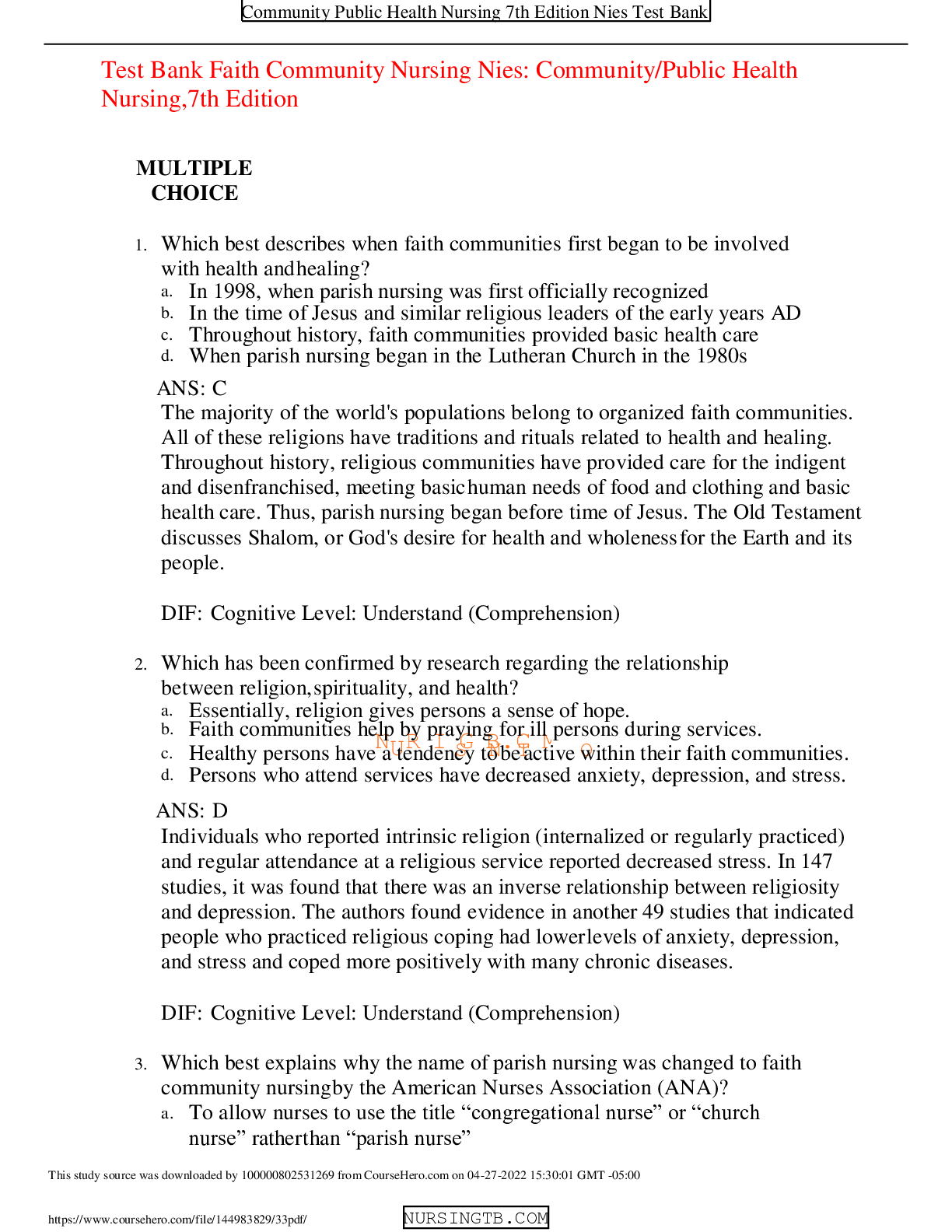*NURSING > TEST BANK > Test Bank Environmental Health Nies: Community/Public Health Nursing, 7th Edition,100% CORRECT (All)
Test Bank Environmental Health Nies: Community/Public Health Nursing, 7th Edition,100% CORRECT
Document Content and Description Below
Test Bank Environmental Health Nies: Community/Public Health Nursing, 7th Edition MULTIPLE CHOICE 1. Which statement best describes the relationship between the environment and health? a. Bec... ause of the large number of variables involved, the relationship between environment and health cannot be researched. b. Because the environment has such long-term effects on health, research findings are not yet available. c. Research shows that a healthy environment has limited impact on one’s health. d. Research shows that a healthy environment increases quality of life and years of healthy living. ANS: D A healthy environment increases quality of life and years of healthy living. Accumulated evidence shows that the environmental changes of the past few decades have profoundly influenced the status of public health. Globally, environmental factors contribute to nearly 25% of all deaths and increase disease burden (World Health Organization, 2016). The safety, beauty, and life-sustaining capacity of the physical environment are unquestionably of global consequence. DIF: Cognitive Level: Understand (Comprehension) 2. When using an environmental perspective, which would be the most important question for a nurse to ask when assessing potential health problems? a. “Can you tell me how you UhavSe beNen fTeeling?O” b. “Can you tell me what you do at work?” c. “What brings you here today?” d. “What problems have you been having?” ANS: B Because 25% of worldwide preventable illnesses are caused by poor environmental quality, nurses need to ask critical questions about their clients’ work and home environments to help discern the contributions of specific hazards to their health. This can be accomplished by an environmental health history. The other responses do not address a question that would be addressed during an environmental health history. DIF: Cognitive Level: Understand (Comprehension) 3. How does critical theory differ from other nursing theories such as the Health Belief Model or Orem’s self-care deficit theory? a. Critical theory can be used by professionals other than nurses. b. Critical theory focuses on oppression and facilitates group action. c. Critical theory is not directly related to health promotion. d. Critical theory confronts changing an individual’s beliefs. ANS: B Critical theory is an approach that raises questions about oppressive situations, involves community members in the definition and solution of problems, and facilitates group interventions. The other two theories focus more on individual beliefs and choice of action. DIF: Cognitive Level: Understand (Comprehension) 4. Which statement best describes why environmental health is more challenging than other variables related to an individual’s health? a. Environmental health affects susceptible individuals more than groups. b. Environmental health demands that individuals be willing to change their beliefs. c. Environmental health is dependent on social neighborhoods, as well as geography. d. Environmental health requires social, economic, and political changes to improve. ANS: D Intervening to improve environmental conditions requires basic social, economic, and political changes. Aggregates must work together to create such change. The other responses do not address the multiple dimensions that must be impacted in order to impact change within environmental health. DIF: Cognitive Level: Understand (Comprehension) 5. Which nursing action would be the most helpful to the community’s long-term health? a. Careful assessment, diagnosis, planning, and giving care to individual patients and their families b. Dialogue with community members concerning what health issues are of importance in that community c. Focusing on family health through school-based neighborhood clinics d. Helping the community creUate SpoliNticaTl changOe through organization, use of media, legislative lobbying, and mass demonstrations ANS: D The ultimate goal is liberating people from health-damaging environmental conditions by using collective actions. Mechanisms have included strategic organization, litigation, public hearing testimony, letter-writing campaigns, legislative lobbying, and mass demonstrations. Helping the community create political change through organization, use of media, legislative lobbying, and mass demonstrations shows how collective action can be applied. The other interventions do not demonstrate the use of collective action. DIF: Cognitive Level: Understand (Comprehension) 6. Which best explains why it is difficult to get others interested in environmental health? a. Environmental problems just are not interesting or dramatic. b. It’s difficult to get media interested. c. People respond more to an acute crisis than chronic environmental problems. d. People respond more to an individual asking for help than a community asking for help. ANS: C People respond to acute crises with dramatic media coverage (such as hurricanes or earthquakes), but ongoing consistent pressure is needed to ensure day-to-day environmental integrity. Chronic environmental problems are rarely addressed effectively. DIF: Cognitive Level: Understand (Comprehension) 7. What would be an appropriate term for intoxicated drivers, secondhand smoke, urban crowding, noise, and mechanization? a. Risks of living style b. Risks in the built environment c. Personal health risks d. Modern day health risks ANS: B The built environment is the connection between people, communities, and their surrounding environments that affect health habits and behaviors, interpersonal relationships, cultural values, and customs. Most people live within areas that require almost daily contact with potential health risks and threats, such as intoxicated or impaired drivers, secondhand smoke, urban crowding, noise exposure, unabated traffic, and the stress of increased mechanization. DIF: Cognitive Level: Understand (Comprehension) 8. What is meant by discriminatory land use? a. Backlash against companies that do not protect the environment b. Daily insults to people who live in a particular community c. Locating industrial hazards in low-income communities d. Political recognition that companies support a safe environment ANS: C Discriminatory land use ensures that many impoverished and marginalized groups, especially people of color, live in close NproRximIity tGo inBdu.sCtrialMcontamination. Members of these communities are at risk for illness and injury. The other responses do not correctly define discriminatory land use. DIF: Cognitive Level: Understand (Comprehension) 9. It has been learned that a particular industry has vastly polluted the surrounding neighborhood. Which action would most likely be taken by those living in the neighborhood? a. Band together to shut the industry down b. Nothing, because of family ties and cost of relocation c. Immediately move to a different neighborhood d. Seek legal reimbursement for the hazard exposure ANS: B Residents may be unwilling to disrupt family ties and cultural roots to start over elsewhere, or they may be unable to afford to move. Residents are revictimized by the difficulty in obtaining compensation. Attempting to shut the industry down, seeking reimbursement for the hazard exposure, and immediately moving to a different neighborhood are all costly interventions and in most cases cannot be easily accomplished by most residents. DIF: Cognitive Level: Apply (Application) 10. Which statement supports why it is believed that the risks of various employment positions are inaccurate? a. Companies refuse to share employee injury information. b. Because factories reimburse employees directly, the injury is not reported. c. Individuals assume it is a personal problem, not an employment issue. d. Most employment positions do not have known risks. ANS: C Statistics do not reflect unreported health problems. Collective problems related to employment or occupation are often perceived as individualized injuries, and no one “connects the dots.” Companies are willing to share employee injury information and recognize the risks of employment, but the information may be inaccurate because of the perception of individualized injuries. DIF: Cognitive Level: Understand (Comprehension) 11. Why are health care providers concerned over such social issues as mass transit, clean power, and the farming industry? a. Because air pollutants are contributors to asthma and other health problems. b. Clean power would reduce the pollution that results from burning of high-sulfur coal. c. Manure runoff from industrial farming is polluting water and killing fish throughout the United States. d. Mass transit would remove the problem of so many Americans being killed or injured by drunken or impaired drivers. ANS: A All three (mass transit, clean power, and industry) emit air pollutants, which result in smog, the most common outdoor air pollutant in the United States. Atmospheric pollutants cause or contribute to asthma, allergic reactions, bronchitis, lung cancer, chronic respiratory disease, and death. They also harm anNimUaRlsSaIndNpGlaTnBts.. TChOe Mmost inclusive answer refers to air pollutants, although certainly, the others are true in society today. DIF: Cognitive Level: Understand (Comprehension) 12. Which statement best describes what has happened to air quality since the United States outlawed the use of chlorofluorocarbons, halons, and carbon tetrachloride? a. Air quality immediately improved. b. Air quality is slowly improving. c. Little change occurred because these chemicals remain in the atmosphere. d. Nothing has happened because other countries worldwide continue to extensively use these products. ANS: C These chemicals, which were in widespread use, remain in the atmosphere. Thus, air quality has not improved. This is a global concern and is being addressed worldwide by the World Health Organization. DIF: Cognitive Level: Understand (Comprehension) 13. Which is the leading cause of lung cancer among nonsmokers? a. Secondhand smoke b. Living near a nuclear power plant c. Exposure to pesticides d. Radon gas ANS: D Radon exposure is the leading cause of lung cancer among nonsmokers in the United States. It is estimated that radon causes an estimated 21,000 lung cancer deaths every year. DIF: Cognitive Level: Understand (Comprehension) 14. Which best describes a food desert? a. The inability to store foods at an acceptable temperature b. The inability to have healthy foods at home c. A neighborhood with little to no access to healthy foods d. A neighborhood that has experienced a recent food-borne illness ANS: C A food desert is a neighborhood with little or no access to healthy foods. There are significant disparities in access to healthy and fresh food supplies, with poor minority families being more likely to live in a food desert. The other responses are not the correct definition of a food desert. DIF: Cognitive Level: Understand (Comprehension) 15. Which issue exists from communities using solid waste landfills to dispose of trash from private residences? a. Landfills are too wasteful, as solid waste can be burned to produce energy. b. Methane gas may move through the soil to cause fire or explosions nearby. c. There is an ongoing need to purchase more land as landfills eventually fill up. d. People do not use landfillNs UbuRt SduImNpGthTeBir.gCarObaMge anywhere they will not be seen. ANS: B Solid waste landfills accumulate methane gas, a byproduct of decomposing organic wastes. Without proper venting, this volatile gas can move through soil and cause fires and explosions in nearby areas. Waste incineration is not the best solution because it causes particulate air pollution. Illegal dumping of garbage and purchasing additional land for more landfills are concerns related to the disposal of trash from private residents, but methane gas explosions is of primary concern. DIF: Cognitive Level: Understand (Comprehension) 16. Which is a direct result of global warming? a. Decreased prevalence of infectious diseases b. Increased water pollution from soil erosion c. Decreased protection from the ozone layer d. Increased number of parasites and insects ANS: D Global warming is the gradual increase in the average temperature of Earth’s near-surface air and oceans since the mid-twentieth century and its projected continuation (Easterling, 2011). Rising global temperatures may enhance the quantity and distribution of parasites, insects, and other disease vectors, potentially increasing the prevalence of a variety of infectious diseases. DIF: Cognitive Level: Understand (Comprehension) 17. Which conclusion can be drawn concerning efforts to decrease environmental pollution? a. The Environmental Protection Agency (EPA) sets priorities for environmental problems and funds action. b. Federal policies have been weakened, and enforcement lacks funding. c. Federal recycling mandates have decreased waste products. d. Legislation is increasingly being passed to force companies to lower toxic waste emissions. ANS: B Legislation in the 1970s was aimed toward a comprehensive national environmental policy. The momentum slowed in the 1980s, with policies being reversed and regulation losing its funding. This trend has continued. The EPA sets rules but lacks resources to accomplish the goals. There are no federal mandates for recycling, but local communities have made great strides in this area. DIF: Cognitive Level: Understand (Comprehension) 18. In a community presentation about asthma, a nurse explained the causes of asthma in children, how to observe for “triggers” that lead to an attack, and how to use an inhaler. Which statement best identifies what was omitted from this presentation? a. The nurse did not ask the attendees to disclose if any of them smoke around children. b. The nurse did not address actions that should be taken to improve air quality and only focused on the treatment of asthma. c. The nurse did not address the need to avoid exposure to others who may have a communicable disease. NURSINGTB.COM d. The nurse did not review the genetic components related to asthma in families. ANS: B By placing responsibility for the cause and cure of health problems exclusively on the individuals, the belief is reinforced that all individuals are free to control their lives. Such a perspective absolves society, government, industry, and business from accountability. Research suggests that changing individual behaviors does not lead to significant reductions in overall morbidity and morality in the absence of basic social, economic, and political changes. Thus, the nurse must include information in the presentation that addresses the need to improve air quality. DIF: Cognitive Level: Apply (Application) 19. The local stream was full of trash. The Boy Scouts had a cleanup day so they could again canoe on the stream. Which action should be taken by nurses in the local community? a. Hold a dialogue with community members about the problem and its effects b. Fight for stronger “do not trash” laws and harsher penalties c. Lecture community organizations about the value of safe water for recreation d. Put all personal trash in appropriate trash receptacles ANS: A An important nursing goal is to help people learn from their own experiences and analyze the world with an intention to change it. It is essential that those affected participate in the process of identifying and working to solve environmental problems. The nurse’s role is to ask critical questions and help groups reflect on the environmental realities of their lives. The only way for the nurse to promote this involvement is through a dialogue with the community members. DIF: Cognitive Level: Apply (Application) 20. Which action should be taken by a small community group who hopes to accomplish goals against a large powerful corporation? a. Appeal to the chief executive officer’s conscience b. Ask the corporation’s employees to encourage change c. Begin legal action to force the corporation to change d. Form coalitions with other groups that have similar goals ANS: D Brainstorm about all possible groups that might have a stake in the outcome of the issue. Nurses can help make connections with larger, more powerful organizations. DIF: Cognitive Level: Apply (Application) 21. How does participatory action research differ from other research methods? a. Participatory action research does not use a control group. b. Participatory action research does not require randomization. c. Participatory action research is not based on a predetermined hypothesis. d. Participatory action research poses solutions to the problem. ANS: D NURSINGTB.COM Participatory action research calls for nurses, community members, and other resource people to work together in identifying health problems, designing the studies, collecting and analyzing the data, disseminating the results, and posing solutions to the problems. The research process (use of control groups, randomization, and using a predetermined hypothesis) is part of participatory action research. DIF: Cognitive Level: Understand (Comprehension) 22. Which strategy should a nurse use to remember what should be included in a health history? a. Always use a preprinted form b. Depend on education to learn this c. Depend on experience to know what to ask d. Memorize the I PREPARE mnemonic e. Memorize the I HEALTH mnemonic ANS: D The I PREPARE environmental exposure history mnemonic is a quick reference for primary care providers. I—Investigate potential exposures P—Present work R—Residence E—Environmental concerns P—Past work A—Activities R—Referrals and resources E—Educate This tool will help the nurse remember what to ask to determine environmental factors relevant to health. DIF: Cognitive Level: Understand (Comprehension) MULTIPLE RESPONSE 1. Which describe a problem with the U.S. water quality today? (Select all that apply.) a. Companies demand high reimbursement when asked to stop dumping heavy metals into local water sources. b. Many aquifers are contaminated with pesticides and fertilizers. c. More than 45 million Americans drink untreated water. d. Sediment from construction, agriculture, and deforestation is often present. e. Underground water, if contaminated, cannot be cleansed. f. Water-related diseases (cholera, typhoid, dysentery) frequently occur. ANS: B, C, D, E More than 45 million Americans obtain water from private wells, which have no treatment or monitoring guidelines. Water quality problems include dosing reservoirs with chemicals to reduce algae, contaminating aquifers with pesticides and fertilizers, and leaching lead from water pipes. Underground water cannot be cleansed. Companies demand high reimbursement when asked to stop dumping heavy metals into local water sources and the frequent occurrence of water-related diseases (cholera, typhoid, dysentery) are not current problems with the water quality in the NUUniRteSd IStNatGesT. B.COM DIF: Cognitive Level: Understand (Comprehension) 2. Which have been identified as part of the core environmental health competencies? (Select all that apply.) a. Assurance b. Assessment c. Policy development d. Management e. Advocacy f. Communication ANS: B, D, F The National Center for Environmental Health, the Centers for Disease Control and Prevention, and the American Public Health Association have established three core competencies for Environmental Health professionals: (1) assessment, (2) management, and (3) communication. Assurance, policy development, and advocacy are not part of the core environmental health competencies. DIF: Cognitive Level: Understand (Comprehension) [Show More]
Last updated: 1 year ago
Preview 1 out of 8 pages
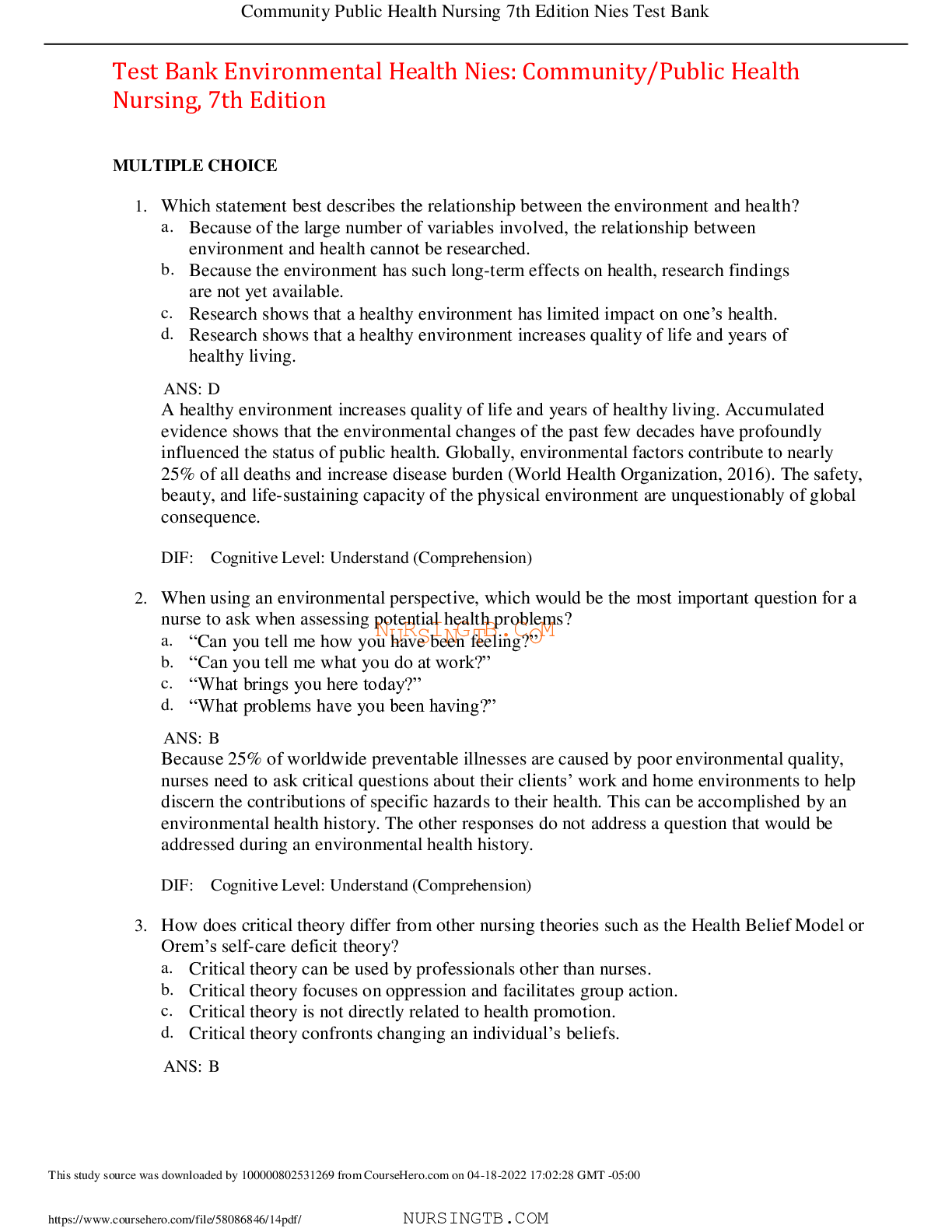
Reviews( 0 )
Document information
Connected school, study & course
About the document
Uploaded On
Apr 19, 2022
Number of pages
8
Written in
Additional information
This document has been written for:
Uploaded
Apr 19, 2022
Downloads
0
Views
26

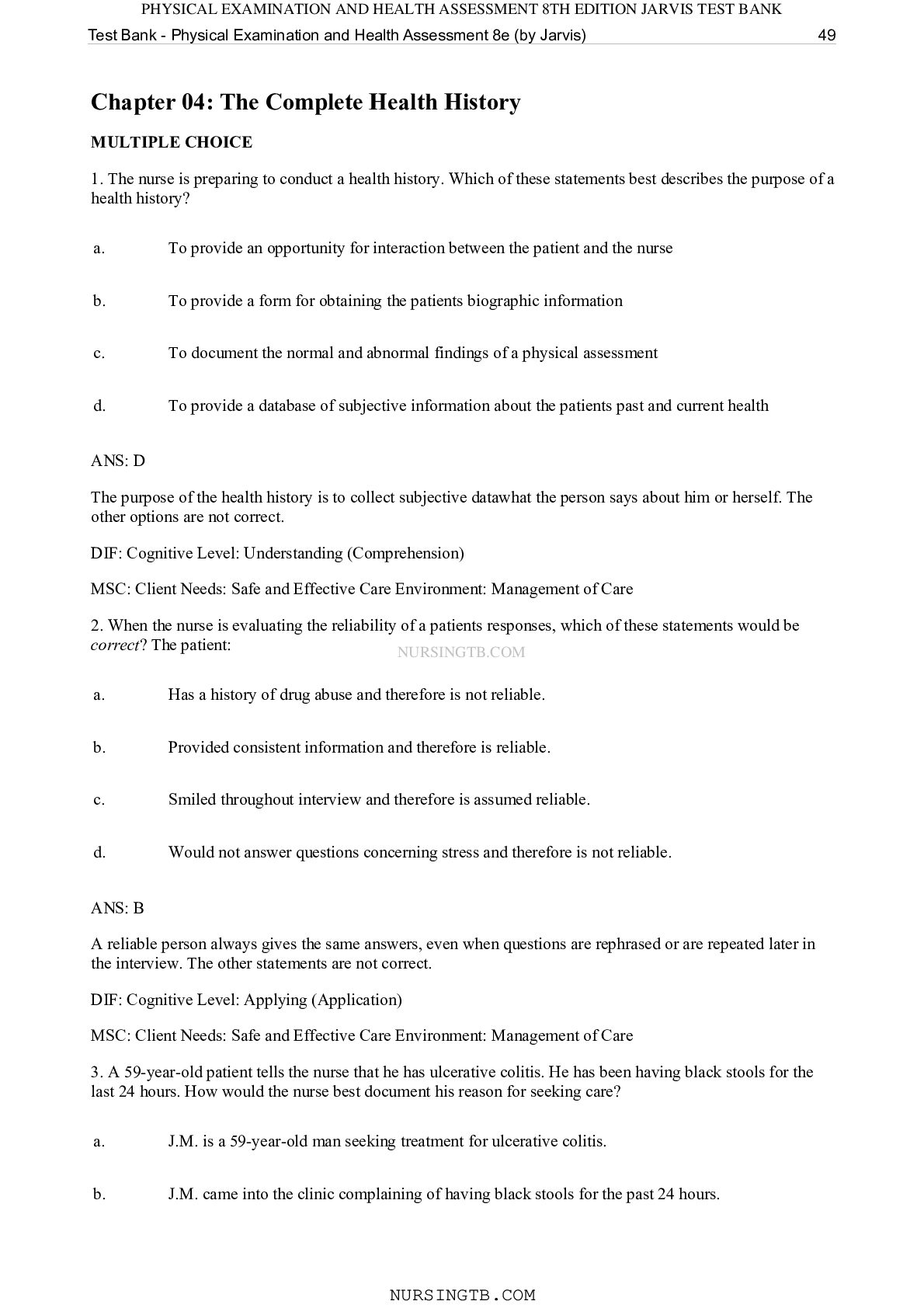









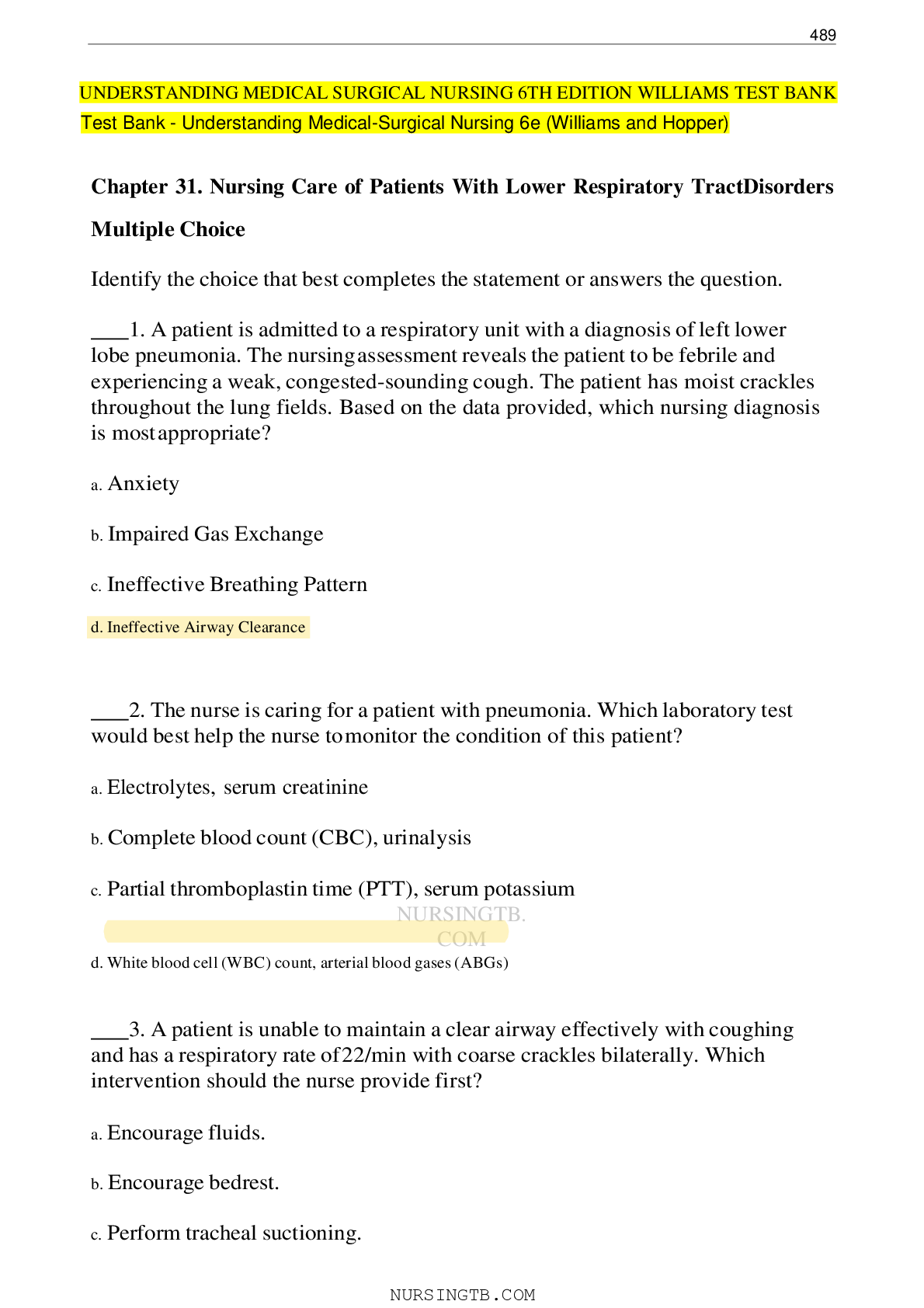

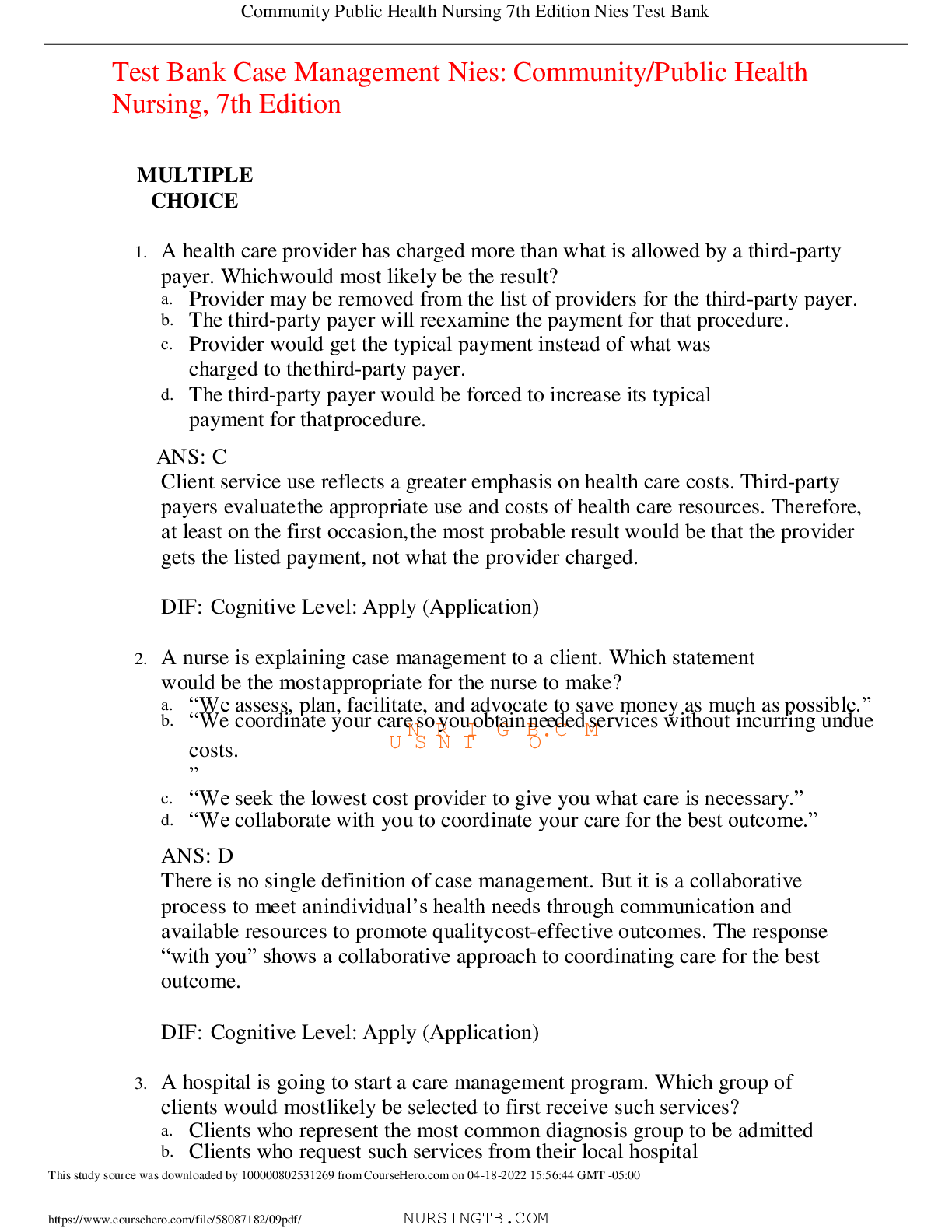

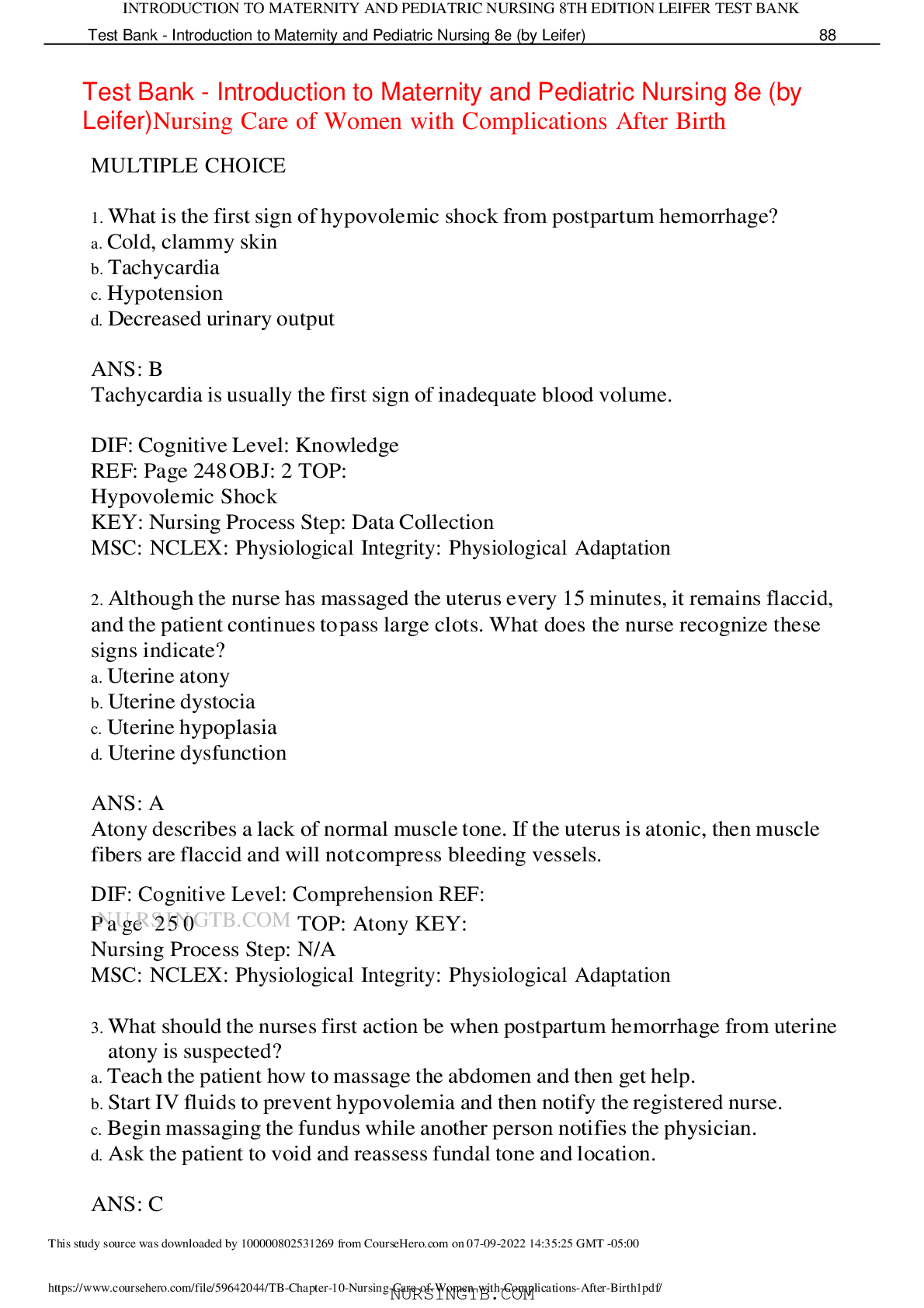



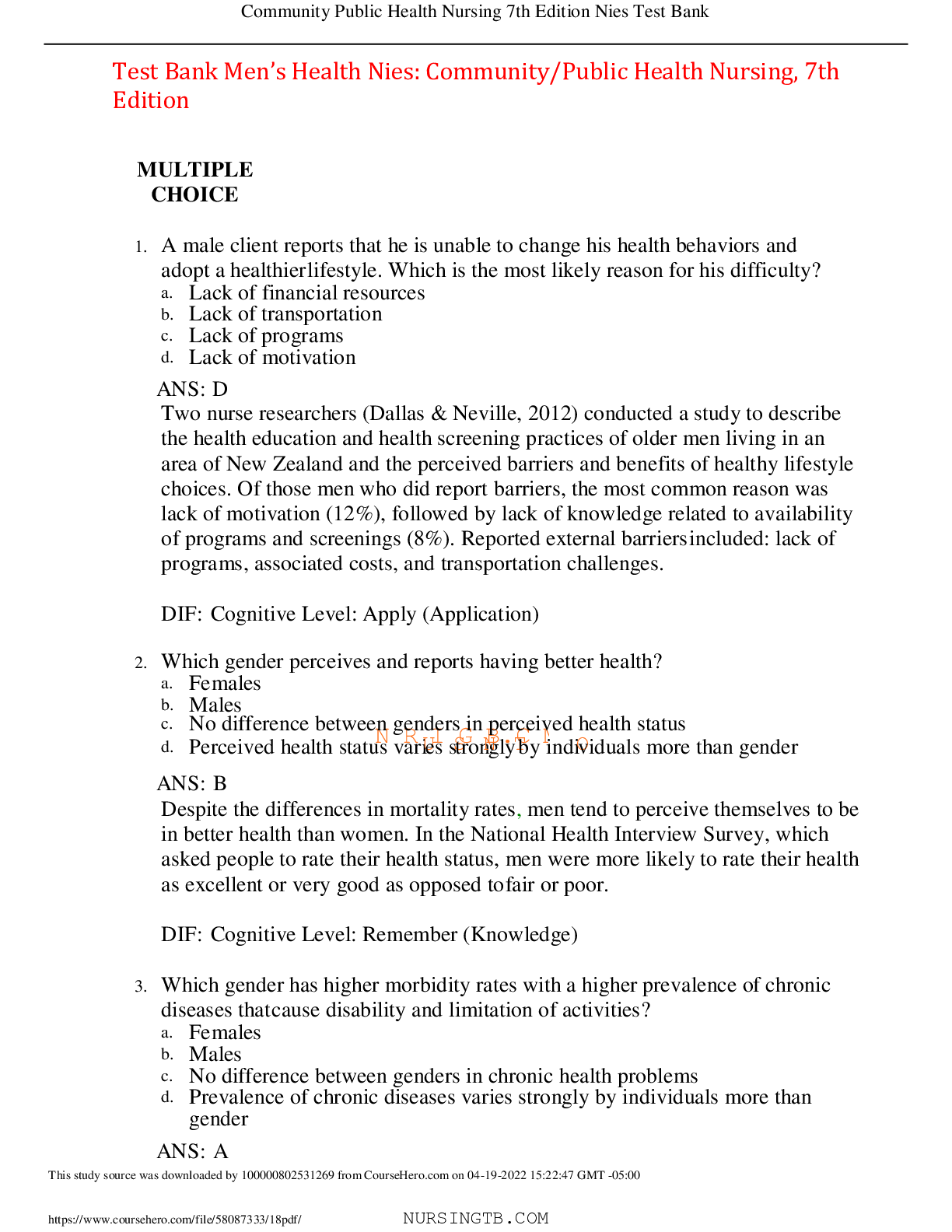
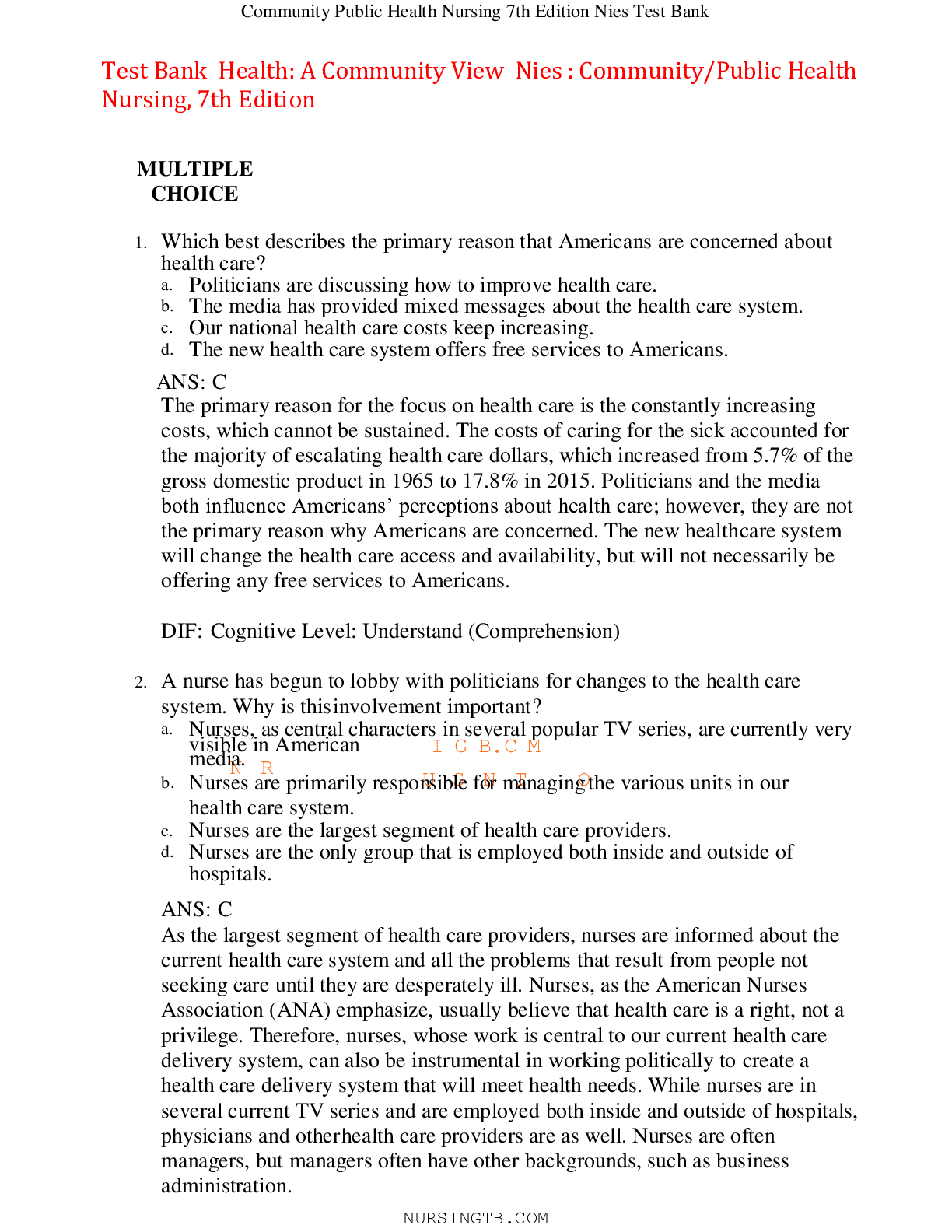
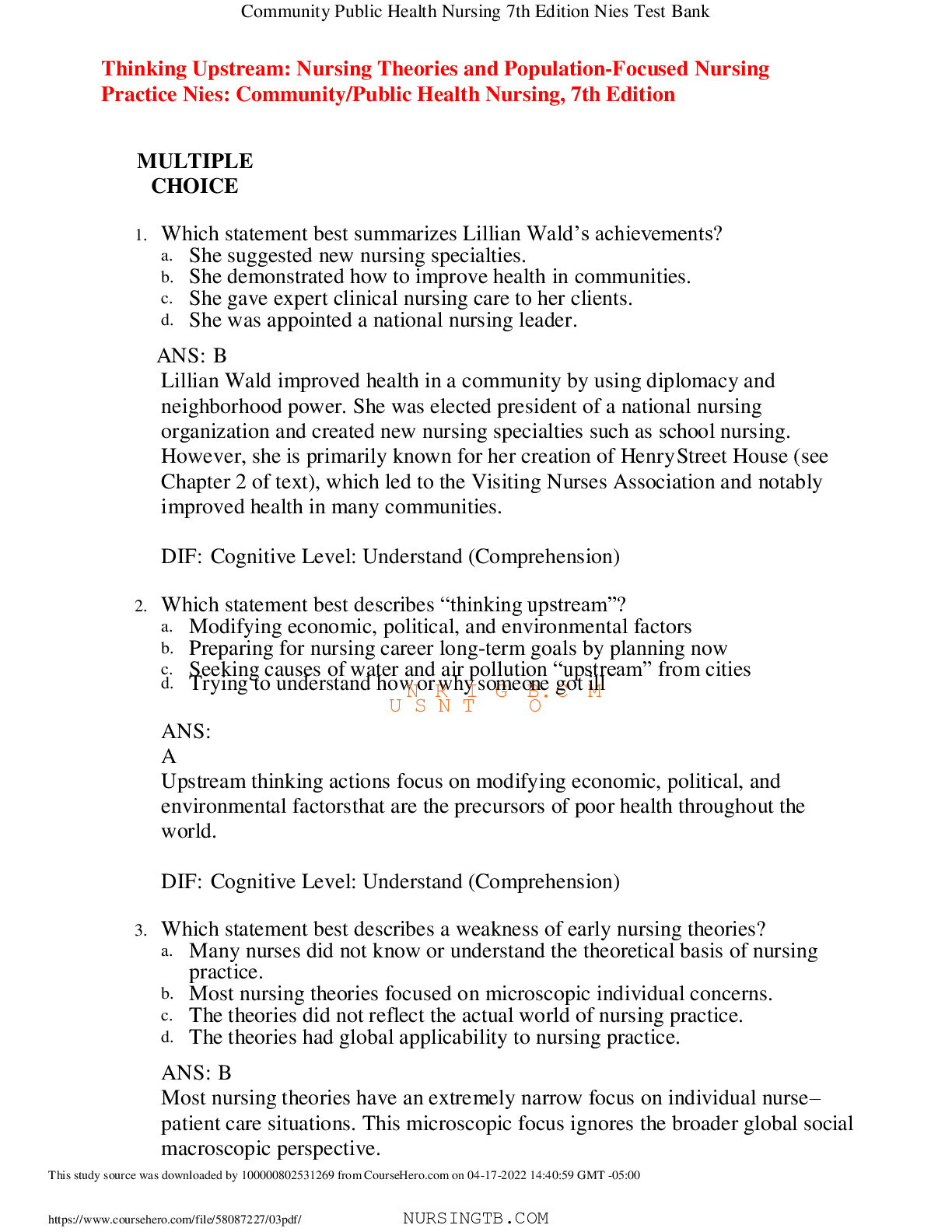

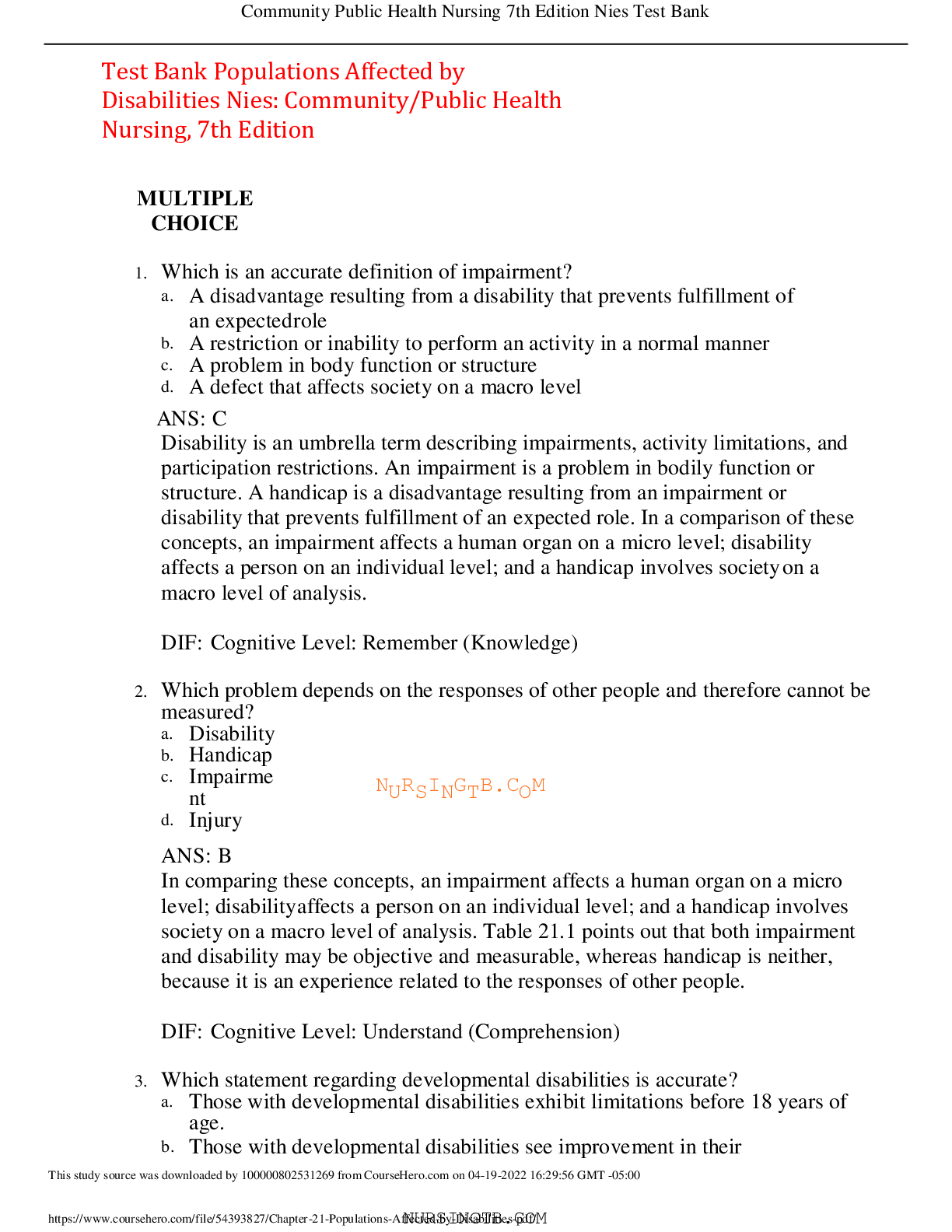


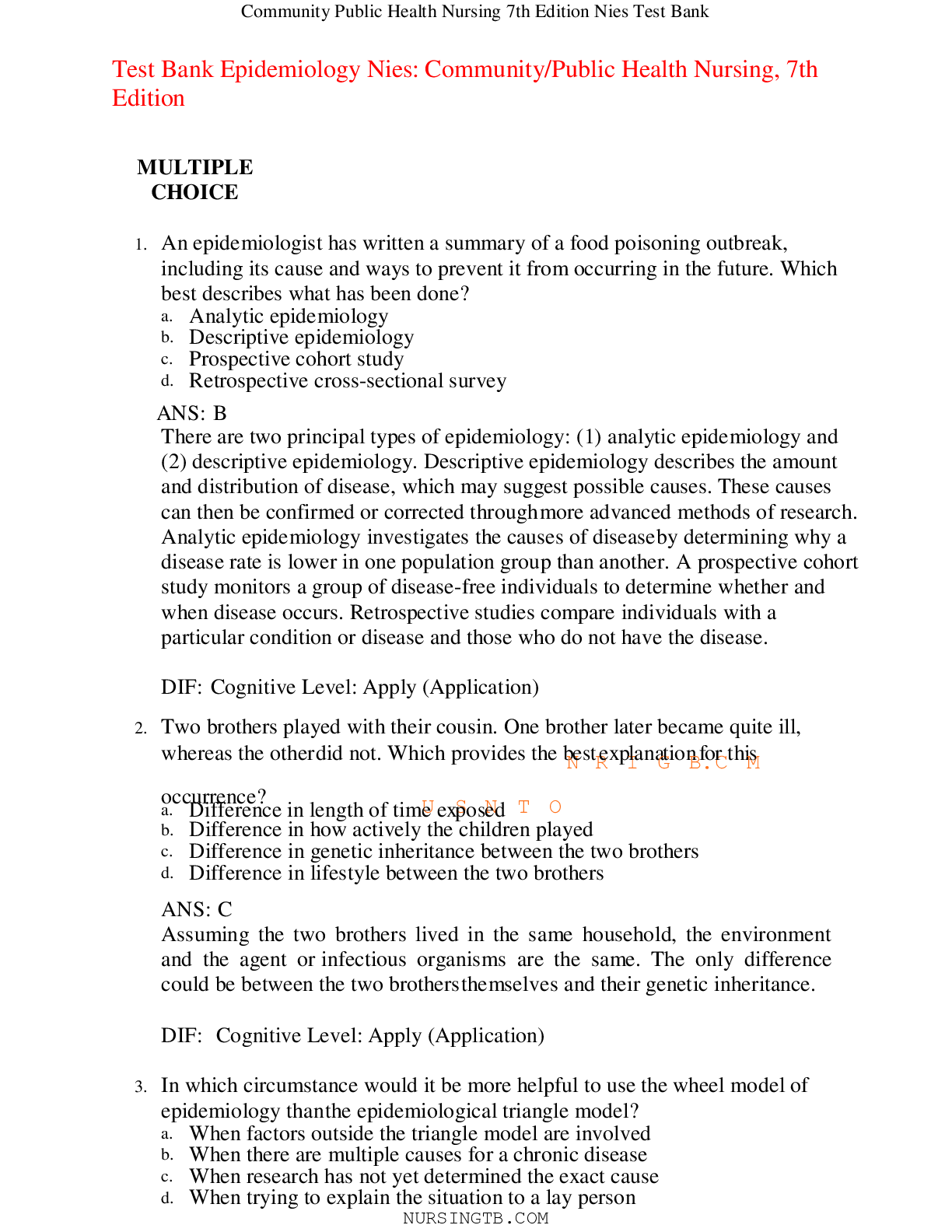
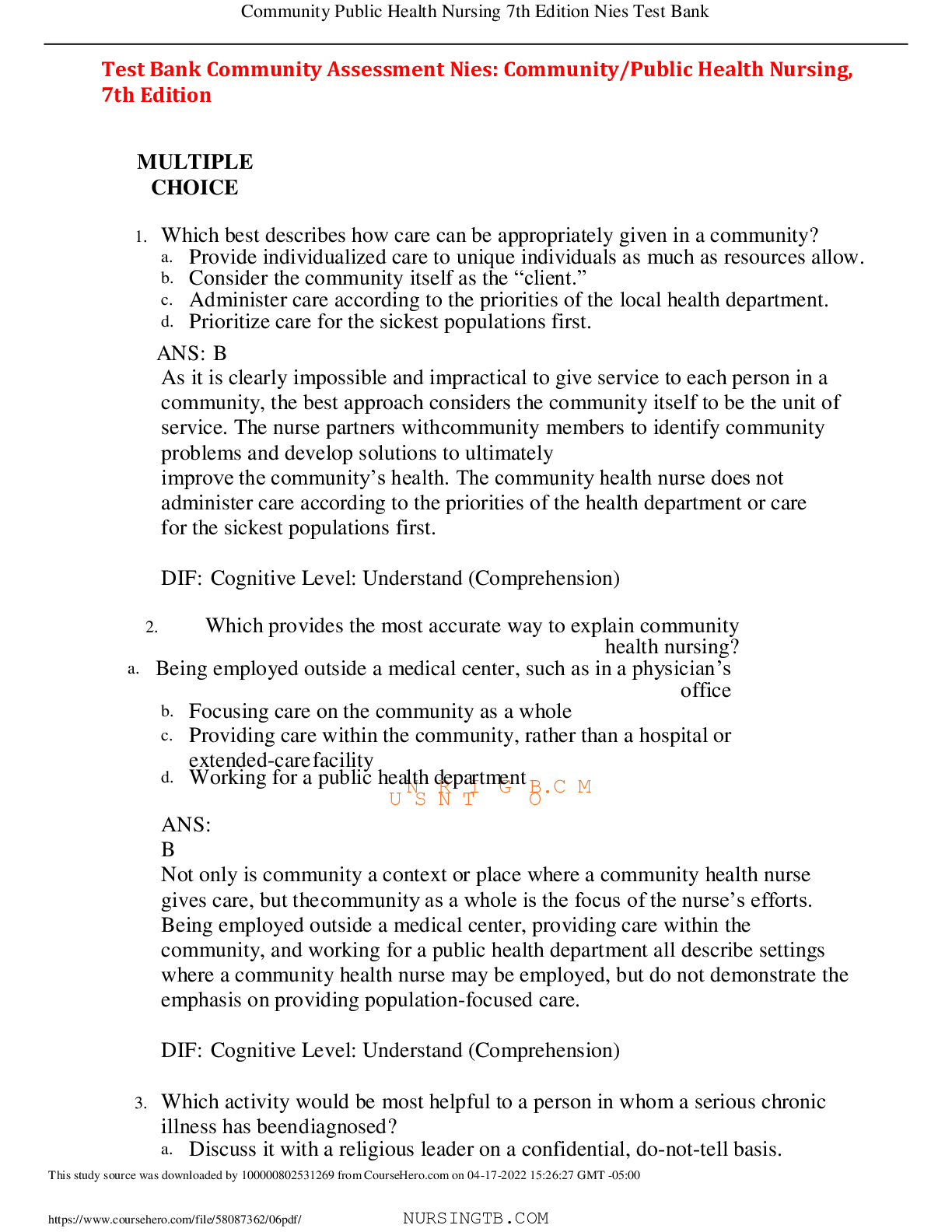


.png)

